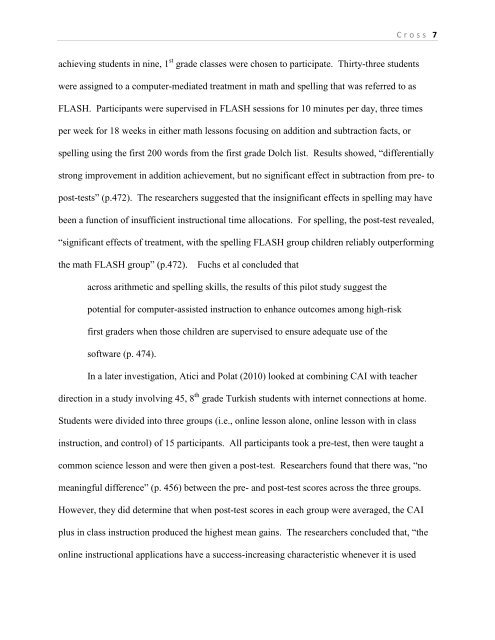THE EFFECTS OF A TIMER AND MYSTERY MOTIVATORS ON THE ...
THE EFFECTS OF A TIMER AND MYSTERY MOTIVATORS ON THE ...
THE EFFECTS OF A TIMER AND MYSTERY MOTIVATORS ON THE ...
Create successful ePaper yourself
Turn your PDF publications into a flip-book with our unique Google optimized e-Paper software.
C r o s s 7<br />
achieving students in nine, 1 st grade classes were chosen to participate. Thirty-three students<br />
were assigned to a computer-mediated treatment in math and spelling that was referred to as<br />
FLASH. Participants were supervised in FLASH sessions for 10 minutes per day, three times<br />
per week for 18 weeks in either math lessons focusing on addition and subtraction facts, or<br />
spelling using the first 200 words from the first grade Dolch list. Results showed, “differentially<br />
strong improvement in addition achievement, but no significant effect in subtraction from pre- to<br />
post-tests” (p.472). The researchers suggested that the insignificant effects in spelling may have<br />
been a function of insufficient instructional time allocations. For spelling, the post-test revealed,<br />
“significant effects of treatment, with the spelling FLASH group children reliably outperforming<br />
the math FLASH group” (p.472).<br />
Fuchs et al concluded that<br />
across arithmetic and spelling skills, the results of this pilot study suggest the<br />
potential for computer-assisted instruction to enhance outcomes among high-risk<br />
first graders when those children are supervised to ensure adequate use of the<br />
software (p. 474).<br />
In a later investigation, Atici and Polat (2010) looked at combining CAI with teacher<br />
direction in a study involving 45, 8 th grade Turkish students with internet connections at home.<br />
Students were divided into three groups (i.e., online lesson alone, online lesson with in class<br />
instruction, and control) of 15 participants. All participants took a pre-test, then were taught a<br />
common science lesson and were then given a post-test. Researchers found that there was, “no<br />
meaningful difference” (p. 456) between the pre- and post-test scores across the three groups.<br />
However, they did determine that when post-test scores in each group were averaged, the CAI<br />
plus in class instruction produced the highest mean gains. The researchers concluded that, “the<br />
online instructional applications have a success-increasing characteristic whenever it is used
















